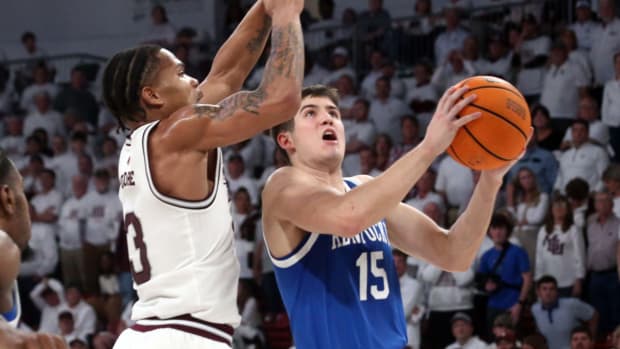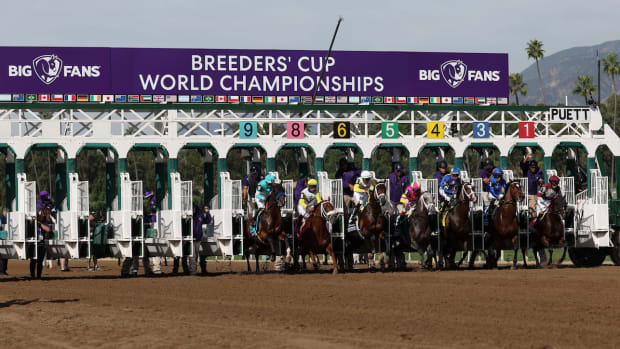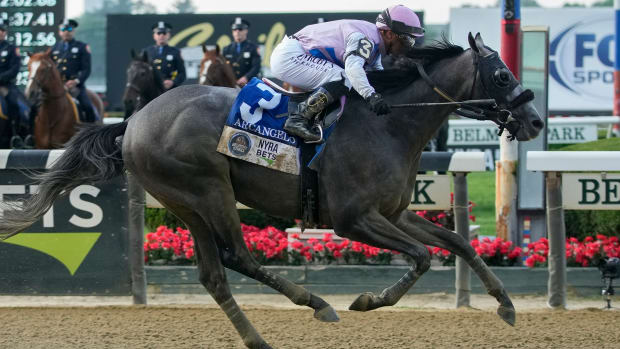Horse Racing's Biggest Problem Will Dominate the 2019 Kentucky Derby
Another Kentucky Derby week has come upon us, which means it’s time to tell stories. Stories of wizened old trainers who have toiled for decades in obscurity, rising before dawn, carried along by the dream that they might someday saddle a horse to run beneath the iconic twin spires. Stories of owners who cobbled together enough cash to buy a two-year-old with some buddies only to discover that he could run like Alydar! Stories of jockeys who emigrated from far away and ride with fury and skill while risking their lives sitting astride 1,000-pound animals thundering over the earth.
The world will listen to these (truly remarkable) stories because this is the week that horse racing rises from the deep rabble of niche sports and becomes, for a fleeting moment, mainstream. This week newspapers and websites and podcasts will carve out little slices of bandwidth alongside the NBA and Stanley Cup playoffs to publicize the Derby. Offices will cobble together Derby pools. Neighbors will gather for Derby parties at which mint juleps even more lethal than those sold at Churchill Downs will enliven the festivities and ruin many Sundays.
And it is the stories that make the Derby. I am frequently asked, incredulously, why I cover horse racing. (It’s a small part of my workload, just a few weeks a year, but visible nevertheless). The reason is simple: Stories. An NFL locker room is often—not always, but often—a vertical community of individuals who have walked similar paths, often young and without life experience beyond the sport they play. (Again, there are exceptions.) The racetrack is humanity, in all its unrepentant splendor. Racing people have lived. They have risen and fallen, celebrated and suffered, succeeded and failed. They have scars and they have stories. Their stories make the game.
So it is 2019. The Derby returns to Louisville for the 145th time, with the scent of two Triple Crown champions—American Pharoah in 2015 and Justify in 2018—on its breath. With 20 three-year-old colts who have endured the prep season to chase roses, history and money for their connections on the first Saturday in May. And there are stories this year. There surely are stories. But not the usual fare.
Here’s one: On the morning of March 14, thoroughbred trainer David Bernstein sent out three-year-old filly Princess Lili B for a half-mile workout on the main track at Santa Anita in Arcadia, Calif. Under exercise rider Pedro Zavaletta, Princess Lili B worked a slow half in 50 2/5 seconds, but just past the finish line she struggled. Zavaletta dismounted to steady the filly, but she fell to the ground. According to Bernstein and Santa Anita officials, Princess Lili B suffered fractures to both front sesamoids (her ankles) and was euthanized by a track veterinarian. (This is a very uncommon injury, but the same injury that felled the filly Eight Belles past the finish line of the 2008 Kentucky Derby.)
Thirty-four days after Princess Lili B was put down, I met with Bernstein at his barn at Santa Anita. We talked while standing outside Stall No. 7, which is where Princess Lili B had lived. Hoop Dream, Princess Lili B’s full brother, has taken the stall. A cranky, white goat sat on a bale of hay, as if guarding the stall, which is what goats do at the racetrack. "Just a sad story," said Bernstein of the deceased filly. "We never had any problems with her at all."
Bernstein is 79 years old, at least six feet tall but a bit slumped. He walks with a little assistance from a cane. He took out his trainer’s license in 1976 and at one time saddled upwards of 300 starters per year. His best was The Wicked North, who as a five-year-old in 1994 won the Eclipse Award for older horses. Bernstein’s business has dwindled in recent years: He sent out only 17 starters in 2017 and 33 last year (although a third of them finished in the money, a solid average). This year he has had only five starters. He is near the end of his career.
Bernstein and his wife, Elizabeth Philippian, bred Princess Lili B. She was born to their then-15-year-old mare, Hello Ruffie, on March 11, 2016, at a farm in Temecula, Calif. "We missed the birth by about 20 minutes," says Bernstein. He tells the story in an even voice, the voice of a man who has seen what the racetrack gives, and takes. Princess Lili B had run two races in her life, most recently finished ninth in a claiming race on Dec. 29. She was not going to be a famous horse; Bernstein was not going to be a famous trainer, like Bob Baffert, whose two barns sit just across a bridle path from Bernstein’s. "We hadn’t lost one in 13 years," says Bernstein. "It’s just very sad. These horses, they’re like part of your family. That morning, the rider said she warmed up really well. Just a very sad accident."
Seventy-four other horses worked that morning, including Baffert’s Kentucky Derby contender, Roadster. The others all made it around safely. Bernstein now has three horses left in his small stable, all of them owned by others. We shook hands, and as I walked away, Bernstein said, "If you write anything, please make it positive, okay?" So that’s a story.
Here’s another one: Princess Lili B’s death was a seismic event at Santa Anita. Twenty-one horses had died from Dec. 24 to March 5, at which time the track was closed for eight days. It reopened on March 13 and on the next day Baffert was being interviewed by the Los Angeles Fox television affiliate when Princess Lili B went down. The siren went off. Fox covered the story. Before the end of the day, Belinda Stronach, president of The Stronach Group, which owns Santa Anita and several other tracks, laid down a list of rule changes that would go into immediate effect as a response to the horse deaths. Among them: A ban on the anti-bleeding medication Lasix, increased transparency in veterinary records and a ban on jockeys’ use of the whip (or ``riding crop’’).
These changes were both praised as revolutionary and progressive and criticized as diversionary, when in fact many trainers argued that the real culprit was the rainy California winter, which washed out the track surface and rendered it unsafe, even as The Stronach Group pushed for bigger fields at Santa Anita. (Bigger fields are important for sustaining the legitimacy of racing as a pari-mutuel proposition, but can run dangerously up against the issue of horse safety.)
It was a very big story that lives today, and grows.
In the ensuing days and weeks, modifications were made to these rules, as the horse community pushed back. The Lasix ban became a phase-in and the whipping restrictions were dialed back. (More on whipping later.) Racing resumed on March 29 and another horse went down a day later. That was 23. Through hundreds of workouts and dozens of races since, there have been no more deaths. The weather has been dry and former track superintendent Dennis Moore returned to Santa Anita and adjusted the racing surface. It’s now deeper, slower and possibly significantly safer. So while The Stronach Group ostensibly sought improved safety through controlling medication, it might have been weather and track care that actually produced that outcome. All of this is under ongoing debate.
Another story that grew from that one: In mid-April, racetracks in New York, Maryland, Florida and Arkansas moved to phase out the use of race-day Lasix in stakes races beginning in 2021. This will bring the U.S. more in line with international racing jurisdictions. It’s a good thing. But at the same time, there’s no definitive study linking Lasix to breakdowns. A new rule can be both a good idea and an inadequate answer, at the same time.
It’s difficult to know where all of this leads, but there is no disputing that the dominant stories in racing in 2019 have had nothing to with racing. They have all stemmed from the deaths of 23 horses at Santa Anita, the attendant publicity and the industry’s attempts to either solve the problem or divert attention from it by mollifying special interest groups. But it’s just starting. Racing would be foolish to think that a Lasix ban is the magic bullet that makes the public forget all those horses lost in California…for whatever reason. And it’s not just California. In late March, Tim Sullivan of the Louisville Courier-Journal reported that Churchill Downs, home of the Kentucky Derby, since 2016, had lost horses at the rate of 2.42 deaths per 1,000 starts, worse than any major track in the U.S. over that span. That statistic can’t be explained by lousy weather.
Here is the larger reality: Racing’s view of itself, from the inside, has never lined up with the public’s view of racing, from the outside. Racing views itself as a broad, passionate community of horse lovers who suffer when any horse dies. And this is an accurate view. However, people outside the racing industry see horses dying and ask: Why does this happen? I can’t stress strongly enough that there are many practical answers to these questions, but no good ones. It should be the racing industry’s goal to bridge this gap, but with the understanding that the only acceptable number of horses lost, and the only number that the greater public can understand, is zero. If racing desires that broader public’s support and affection, it must visibly and effectively move toward zero deaths, despite the reality that zero deaths is not practically achievable.
This disconnect can lie dormant for years, until there is a very public breakdown (see: Ruffian, Barbaro), and then the public questions the sport. (And special interest groups rise to use this momentary outrage to their advantage.) We are in the midst of another such surge of awareness, but this does not feel like a blip. The violence of football was not only overlooked, but romanticized, for generations, until suddenly, in the last decade, it is no longer accepted. Football has been rushing to change the nature of itself. It’s impossible to know if racing has truly reached a similar tipping point, but racing would be unwise to test its durability in this climate.
There are big issues and small ones. There is unquestionably a need for unified oversight, but that seems distant. The medication rules are a step, but can seem like weird science, as well. Whipping is an issue. Knowledgeable horsemen and jockeys will explain in detail that whips are more than a tool to punish a tired horse and make him run faster; they are a vital tool in safely controlling a tired racehorse. But the image of a jockey smacking a tired horse and resultant crack (even if that crack is deceptively loud with modern, softer whips) is a terrible image and a fearsome sound. It is worth working on. (Earlier this spring, I interviewed trainer Graham Motion about the state of the game; he told me that he has encouraged his riders to be aware of their surroundings when using the whip and in their behavior toward horses in general. People are watching and what an exercise rider might see as customary treatment of a stubborn horse, a novice railsider might read as cruelty.)
This will be my 18th consecutive Kentucky Derby. It has been a wellspring of storytelling opportunities. My second Derby was won by Funny Cide, with his group of small-town, Regular Joe owners. My third was the remarkable Smarty Jones. I saw Giacomo and Mine That Bird win at 50-1. I went to California to meet California Chrome’s memorable owners and then saw him nearly win the Triple Crown. Then I saw Pharoah and Justify actually win the Triple Crown.
There is no shortage of similar stories this year. I can run my index finger down the PPs, close my eyes and envision a compelling race lede on more than half the field. So much good stuff. Sign me up.
But there’s a bigger story this year. It’s a story that came tragically to life in California, but lives across the breadth of the sport, at every track where jockeys get a leg up. That story is this, and must be true this weekend in Kentucky: No dead horses.




